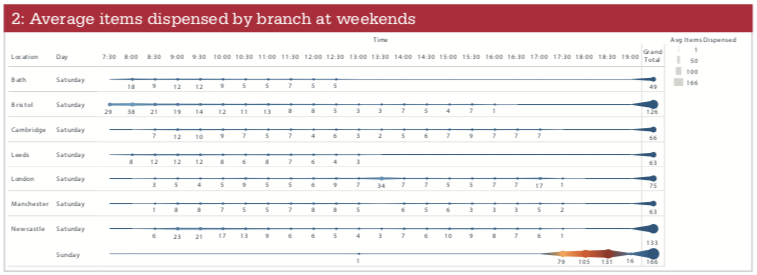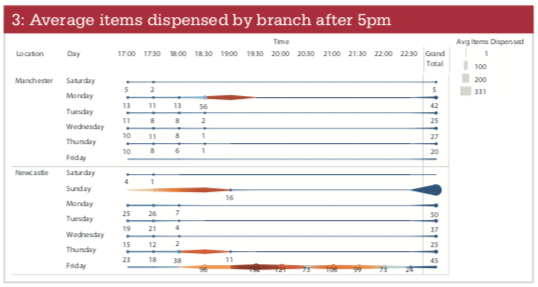Quick wins for improved performance
In Running Your Business
Follow this topic
Bookmark
Record learning outcomes
In the first article in this series, I explored the first five points of 20 areas (see box) that need to be done consistently to maximise your business performance. Improving performance in the next five will help you realise quick wins in revenue, patient care and increased efficiency. Important decisions should be based on accurate data, so all require clear visibility of your information, available at the time you need it. Let’s dive in.
6. Get a routine going to get full allocation of NMS interventions
It is possible to do as many, or more, NMSs as MURs each month, although in practice, pharmacies do a lot less. With good information, processes and the right level of resource, continuous improvement can drive these numbers up significantly. Increases are achievable.

Figure 1 shows that an average of 76 NMS were completed by the industry over the 12 months to September 2018, with independent multiples with 50 or more branches doing the most (127).
When we take a closer look at those averages, we can see that there are 40 groups doing more than 100 NMS per branch per annum, but five groups are doing more than 200, and two groups are topping 300 NMS per branch per annum.
Perhaps one of these should be your new target for NMS completions in the year?
7. Max out the Quality Payments Scheme and Flu vaccinations
The Quality Payments Scheme, including engagement with Summary Care Records, can be tracked to ensure that full payment is achieved. The nature of the payment, with two review dates each year, lends itself to diarising over 12 months. Make sure you’re up to date with the gateway criteria a month in advance of the review dates, and don’t forget your NHS website data. Make a diary note to check it’s correct in the month before the review point. Don’t overlook the clinical governance aspects of the QPS. Elements like the audit and the safety report result in payments, and they also contribute data to the national medicines optimisation dashboard, serving as proof of the contribution of the network as a whole. Don’t overlook flu vaccinations either. They are very enthusiastically done by many branches, and inconsistently in others. Careful management, and better community care through improving immunisation rates, can drive more profit. Clarity around goal, and tracking, can ensure improved performance.
8. Look after CCG and LPC-led commissioned services
It’s harder to generalise here, but we have noted that CCGs and LPCs contract pharmacies to do other ad-hoc services. In some areas these can be worth as much as the national MUR and NMS services. Use tools such as PharmOutcomes to assemble the reporting, and support process improvement. If you can augment this with data driven decision making – you can get reporting in real time for many of these services, you will be able to do a really good job on these too.
9. Optimise your hours – can they be reduced?
 For pharmacies not on 100 hour contracts, looking at the benefit of weekend and after 5pm opening is something to be carefully considered. We see many customers with sophisticated resourcing models with regard to hours required, but a tool to review these every 6 months in line with changes in the business will deliver better results.
For pharmacies not on 100 hour contracts, looking at the benefit of weekend and after 5pm opening is something to be carefully considered. We see many customers with sophisticated resourcing models with regard to hours required, but a tool to review these every 6 months in line with changes in the business will deliver better results.
In Figures 2 and 3, we can see that opening after 5pm on Friday and Sunday is crucial to Newcastle’s business. For some of the other branches, if Saturday opening were non-contractual, there’s a decision that could be made over the relative importance of those hours, particularly in the afternoons.
 10. Achieve consistency across branches
10. Achieve consistency across branches
We are all human, so not unreasonably we struggle to deliver machine-like consistency in how we operate. But, as a result, things will be left behind unless we can see dashboards or scorecards of where we stand in relation to businesses like ours. Pharmacies that deliver exceptional performance will hold lessons we might all learn from, while those at the other end of the scale have considerable potential and opportunity for improved performance.
In groups, good area management and quality information are indispensable to ensure nothing is left behind. Using an effective system to provide the same information to head office managers, area managers and branch managers, in the format they need to do their jobs, can be transformational in the right hands.
20 steps to improve your business with data
1. Claim Controlled Drug, electronic repeat dispensing and other EPSR2 prescriptions on time
2. Manage unclaimed prescriptions – deal with month-end and outstanding EPS prescriptions
3. Get exemptions right
4. Move dead stock every quarter
5. Complete MURs consistently each month
6. Get a routine going to get full allocation of NMS interventions
7. Max out the Quality Payments Scheme
8. Look after CCG and LPC-led commissioned services
9. Optimise your hours – can they be reduced?
10. Achieve consistency across branches
11. Grow electronic repeat dispensing to 10-20 per cent of prescriptions
12. Take an eagle eye view of the local competition and take action
13. Grow EPS nominations to 90 per cent of repeat customers
14. Follow up ‘overdue’ patients
15. Match expensive items
16. Unload unprofitable care homes
17. Negotiate for better cost prices where price is greater than Drug Tariff reimbursement
18. Review supply chain shortages, focusing on key margin products and concessionary prices
19. Check temporary safeguarding payments
20. Review local use of branded generics
